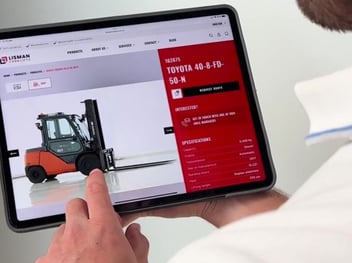Balancing extremes: normalisation the latest trend in forklift industry
How supply chain recovery and cooling demand reset the forklift markets
The forklift industry has undergone a dramatic shift. The days of extreme shortages and skyrocketing prices are behind us, replaced by a market with ample supply and a more balanced pricing structure. What was once a seller’s market has firmly transitioned into a buyer’s market, forcing manufacturers, traders and dealers to adapt at speed.
With 2024 marking a turning point – driven by cooling demand and resolved supply chain issues – the industry now faces a new set of challenges. The influx of used machines, an overstock of rental fleets and economic uncertainty in key markets like Germany are reshaping the playing field. Meanwhile, price corrections, sustainability demands and workforce shortages are adding new layers of complexity to the second-hand machinery trade.
What lies ahead for 2025? Will we see further price stabilisation or will supply-side pressures drive another shift? In the second part of our Market Outlook 2025, CEO Koen Lisman explores the trends, risks and opportunities defining the next phase of the forklift industry.
With supply chain issues being resolved and market demand cooling off, massive shortages of machines shifted to ample availability across the industry as a whole. As predicted. While 2023 saw a drop-off in the number of machines sold, there was still the tail end of COVID-19 suppliers had to deal with. Many previous orders still needed to be delivered. Ultimately the material handling machinery pipeline became less jammed, clearing the way for a welcoming reset.
“In 2024 the market transformed from a seller’s market to a buyer’s market – a healthy development”, Koen says looking back to the imbalance and skyrocketed machinery prices. Demand normalised, manufacturers overcame delivery problems, levelling off the ‘market madness’. “Due to the market situation, prices for used machines were high – too high. With the lack of availability of new machines, used equipment became the much sought-after answer.”
The lower order intake in 2024 has left its mark on the industry as a whole. Less machines ordered, less machines shipped: the second hand machinery trade needed to adapt. Quickly. And 2025 looks to be no different. OEM’s have invested heavily in (short-term) rental fleets which have become too big. “With the rental armada being docked, we are preparing for a vast influx of used material handling machines to enter the second hand market.”
The German crisis
After two years of economic recession, industries worldwide are closely monitoring the trials and tribulations of the worlds’ third largest industry. “No less than 25 percent of all used forklifts in Europe are located in Germany. If the regression progresses, this can lead to a massive increase in used machines coming to market. We can’t underestimate or trivialize the impact of Germany on the European market. This can lead to major market shifts and disruptions.”
Not all manufacturers were paying attention to what the market was telling them. The German economy, for instance, is a clear example of how a lack of innovation and adaptability can directly impact a business. Nationwide economic issues are pushing the industrial sector on the verge of collapse. In the specific case of Linde, this has led to alarming numbers: a whopping 40% decrease in sales domestically. A clear example of not anticipating on where the market is heading for.
‘Greed-flation’
“Part of the decline of the German machinery market is down to none of the dealers investing in short-term rental fleets. And because of the lack of investment, they’re paying double the price. This has an impact on the pricing of new machines too.” From a broader perspective the price correction was long overdue. The huge rise in the costs of new machines over the last few years, now turns out to partly be a case of ‘OEM driven inflation’. “We have a suitable word for this in Dutch: ‘greed-flation’.”
“The average 30% price increase on new machines can be cut in half. It’s a temporary margin. New machines will settle at a new, normalised price and the price of used machines, which became very cheap in 2024, will grow to a regular level. In reality this means the unhealthy price delta between new and used machines will disappear, especially as readily available common used machines become more and more scarce.”
How does it add-up?
This shortage of used machines that don’t require a lot of mechanical care and attention is exacerbated by another ongoing deficit: the lack of qualified personnel. “Who’s going to fix and refurbish these machines? A lot of dealers and traders don’t have the hands nor the manpower. This means they will stay away from used machines that need a great deal of refurbishment. Let alone the added costs. At the end of the day, every investment has to add up.”
Bearing all this in mind, Koen expects 2025 to be a year of transition. From a surplus to normalisation – followed by potential shortages of highly desirable machines. “Both the markets for used and new machines are stabilising. Net discounts are growing higher and the price delta between new and used machinery is now at a far more healthier level – and we expect that these levels will remain.”
Market bias
New machines are becoming more attractive again, as do used forklifts. But, there’s a clear market bias when it comes to used machines. “The trade-off between buying a new machine or a used machine is down to alternatives. We expect a straightforward shift in price delta within the used machinery industry. The price gap between used ‘as-is’ and ‘ready-for-use’ will grow. The demand for machines that can be shipped directly after purchase, is rising fast.”
The regained popularity of used forklifts and second hand machinery is fuelled by various challenges and trends many professionals have to deal and comply with. The continued lack of skilled technicians and engineers, for one. And then there’s the new societal and regulatorily expectations and compliance to abide by, ensuring sustainability is a main topic in today’s and tomorrow’s corporate activities. This causes market-wide concern. ‘We want to, but can we?’.
“With used machinery it’s simple, but harsh maths: the economical lifespan vs technical lifespan. Whether it’s based on your own conviction, political pressure or society’s expectations, it has to add up. Yes, companies feel the pressure to become more sustainable and they are willing to pay the ‘price’, but it has to be economically viable. That being said, this years’ market for ready to use pre-owned forklifts will become a seller’s market after a relatively short period (post Covid) in which the buyers had their say.”
Balancing extremes
“The heavy fluctuations caused by COVID-19 led to this drastic market shift. Now, we're witnessing the opposite effect, indicating a market normalisation. Despite a temporary decline in order intake, growth is still projected. Especially since the recent European investment agenda has been launched following the increased global geopolitical instability. The extreme outliers we've experienced are flattening. We're returning to normal cycles. Current peaks and exceptions are rectifying earlier market shifts, one extreme evens out the other.”



